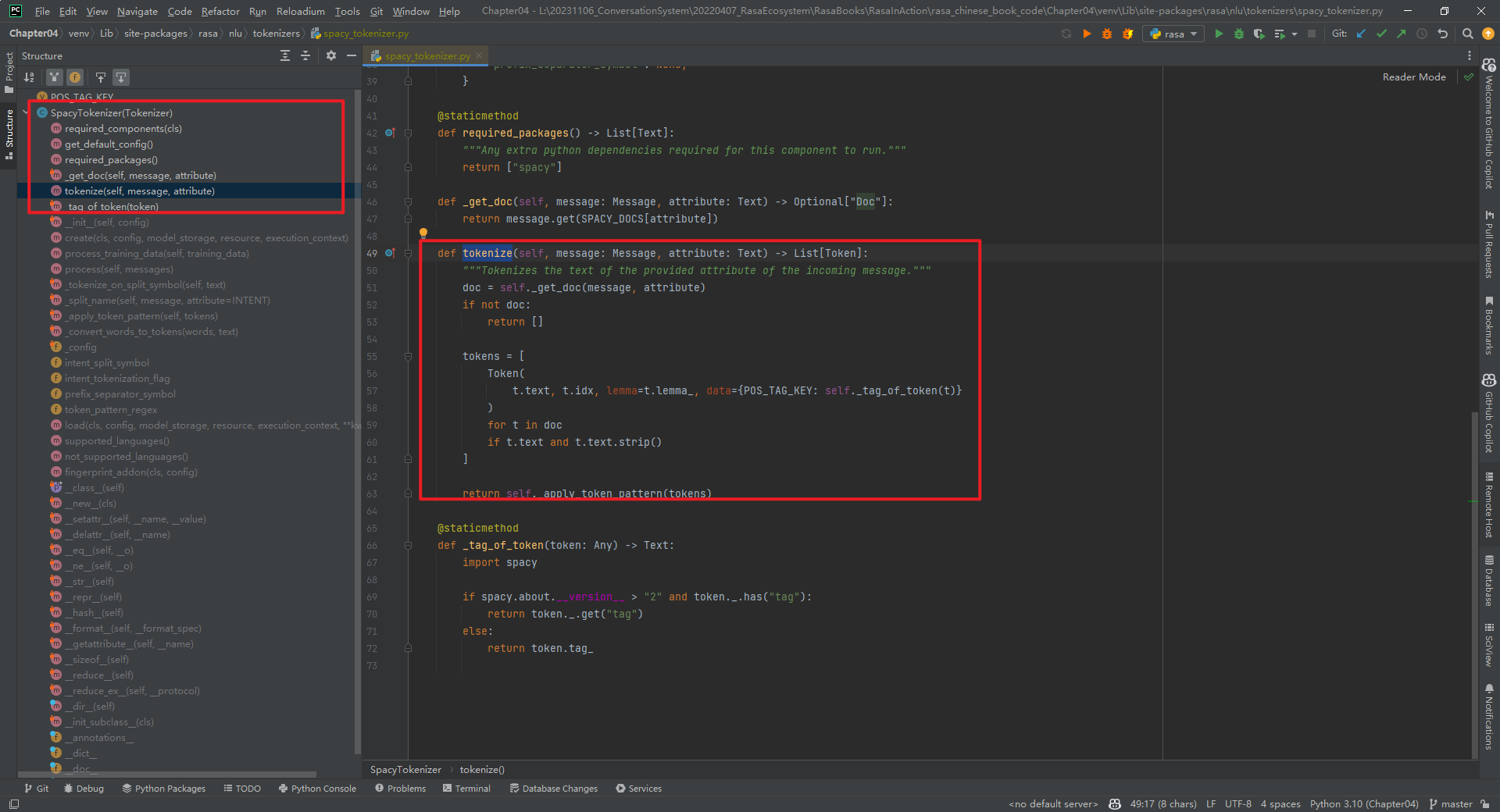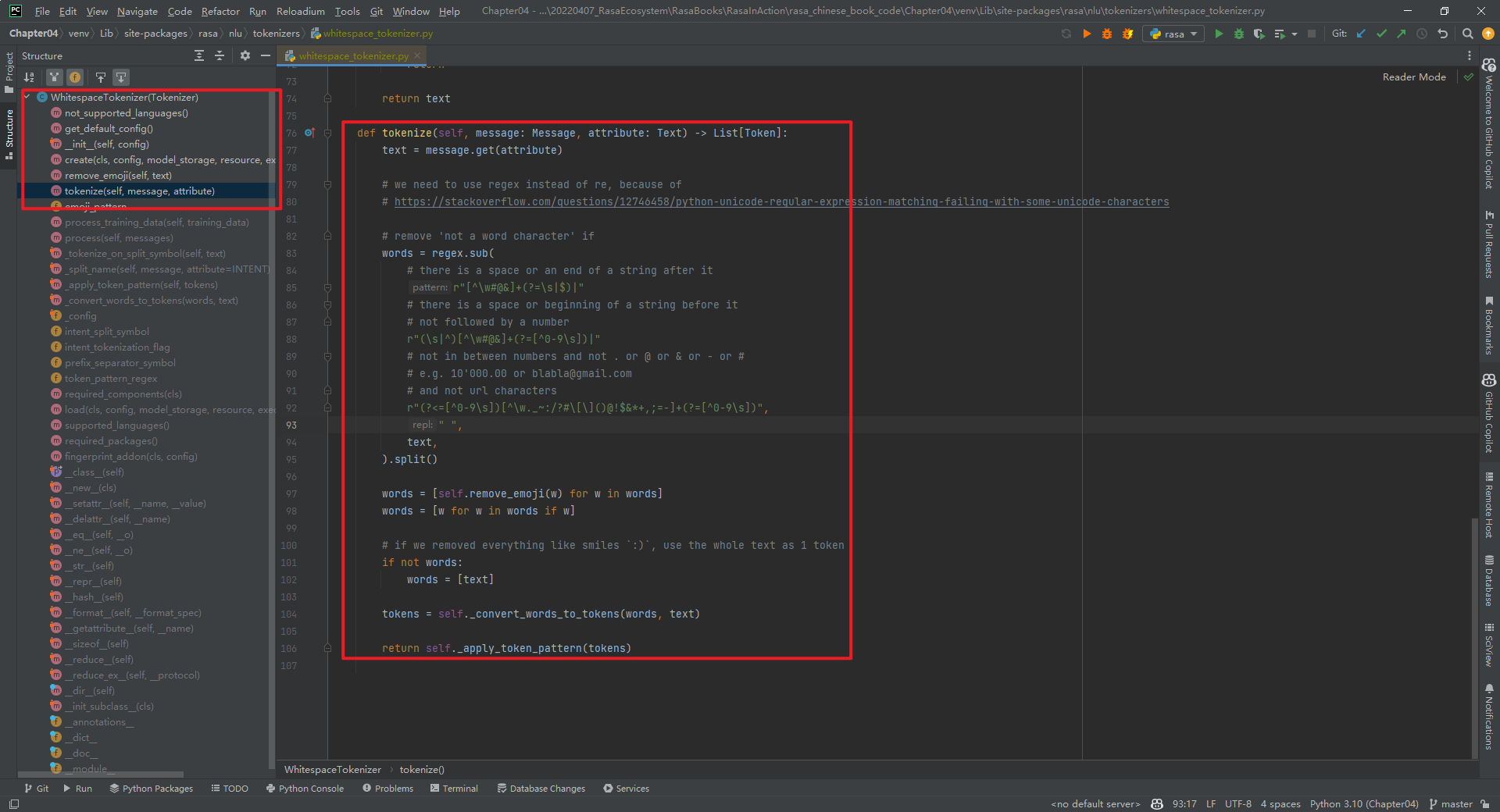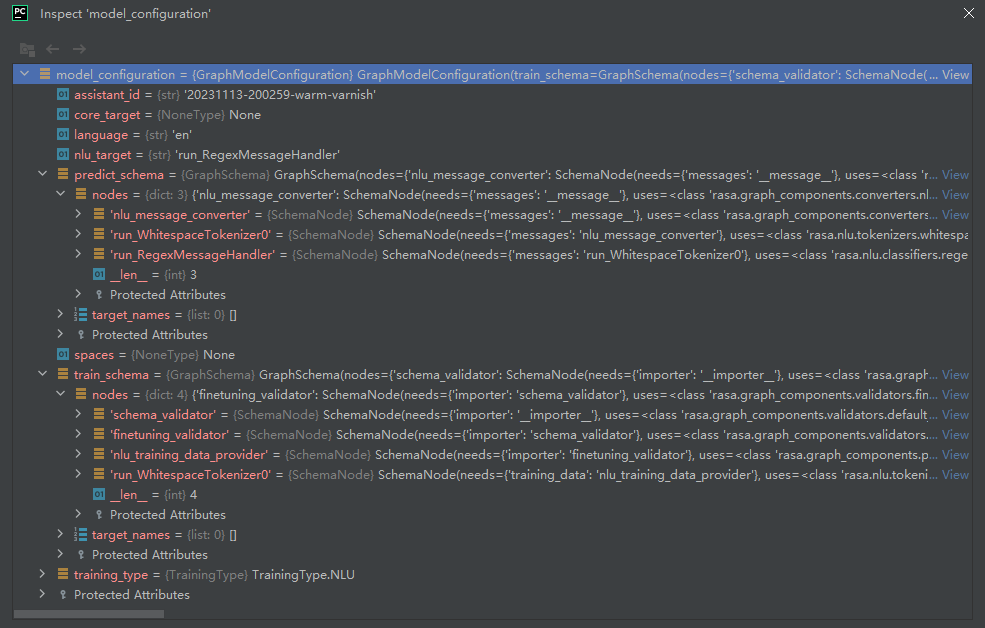一.JiebaTokenizer
JiebaTokenizer类整体代码结构,如下所示: 加载自定义字典代码,如下所示[3]:
加载自定义字典代码,如下所示[3]:
@staticmethod
def _load_custom_dictionary(path: Text) -> None:
"""Load all the custom dictionaries stored in the path. # 加载存储在路径中的所有自定义字典。
More information about the dictionaries file format can be found in the documentation of jieba. https://github.com/fxsjy/jieba#load-dictionary
"""
print("JiebaTokenizer._load_custom_dictionary()")
import jieba
jieba_userdicts = glob.glob(f"{path}/*") # 获取路径下的所有文件。
for jieba_userdict in jieba_userdicts: # 遍历所有文件。
logger.info(f"Loading Jieba User Dictionary at {jieba_userdict}") # 加载结巴用户字典。
jieba.load_userdict(jieba_userdict) # 加载用户字典。
实现分词的代码为tokenize()方法,如下所示:
def tokenize(self, message: Message, attribute: Text) -> List[Token]:
"""Tokenizes the text of the provided attribute of the incoming message.""" # 对传入消息的提供属性的文本进行tokenize。
print("JiebaTokenizer.tokenize()")
import jieba
text = message.get(attribute) # 获取消息的属性
tokenized = jieba.tokenize(text) # 对文本进行标记化
tokens = [Token(word, start) for (word, start, end) in tokenized] # 生成标记
return self._apply_token_pattern(tokens)
self._apply_token_pattern(tokens)数据类型为List[Token]。Token的数据类型为:
class Token:
# 由将单个消息拆分为多个Token的Tokenizers使用
def __init__(
self,
text: Text,
start: int,
end: Optional[int] = None,
data: Optional[Dict[Text, Any]] = None,
lemma: Optional[Text] = None,
) -> None:
"""创建一个Token
Args:
text: The token text. # token文本
start: The start index of the token within the entire message. # token在整个消息中的起始索引
end: The end index of the token within the entire message. # token在整个消息中的结束索引
data: Additional token data. # 附加的token数据
lemma: An optional lemmatized version of the token text. # token文本的可选词形还原版本
"""
self.text = text
self.start = start
self.end = end if end else start + len(text)
self.data = data if data else {}
self.lemma = lemma or text
特别说明:JiebaTokenizer组件的is_trainable=True。
二.MitieTokenizer
MitieTokenizer类整体代码结构,如下所示:
核心代码tokenize()方法代码,如下所示:
def tokenize(self, message: Message, attribute: Text) -> List[Token]:
"""Tokenizes the text of the provided attribute of the incoming message.""" # 对传入消息的提供属性的文本进行tokenize
import mitie
text = message.get(attribute)
encoded_sentence = text.encode(DEFAULT_ENCODING)
tokenized = mitie.tokenize_with_offsets(encoded_sentence)
tokens = [
self._token_from_offset(token, offset, encoded_sentence)
for token, offset in tokenized
]
return self._apply_token_pattern(tokens)
特别说明:mitie库在Windows上安装可能麻烦些。MitieTokenizer组件的is_trainable=False。
三.SpacyTokenizer
首先安装Spacy类库和模型[4][5],如下所示:
pip3 install -U spacy
python3 -m spacy download zh_core_web_sm
SpacyTokenizer类整体代码结构,如下所示: 核心代码tokenize()方法代码,如下所示:
核心代码tokenize()方法代码,如下所示:
def tokenize(self, message: Message, attribute: Text) -> List[Token]:
"""Tokenizes the text of the provided attribute of the incoming message.""" # 对传入消息的提供属性的文本进行tokenize
doc = self._get_doc(message, attribute) # doc是一个Doc对象
if not doc:
return []
tokens = [
Token(
t.text, t.idx, lemma=t.lemma_, data={POS_TAG_KEY: self._tag_of_token(t)}
)
for t in doc
if t.text and t.text.strip()
]
特别说明:SpacyTokenizer组件的is_trainable=False。即SpacyTokenizer只有运行组件run_SpacyTokenizer0,没有训练组件。如下所示:
四.WhitespaceTokenizer
WhitespaceTokenizer主要是针对英文的,不可用于中文。WhitespaceTokenizer类整体代码结构,如下所示: 其中,predict_schema和train_schema,如下所示:
其中,predict_schema和train_schema,如下所示:
rasa shell nlu --debug结果,如下所示: 特别说明:WhitespaceTokenizer组件的is_trainable=False。
特别说明:WhitespaceTokenizer组件的is_trainable=False。
五.BertTokenizer
rasa shell nlu --debug结果,如下所示:
  BertTokenizer代码具体实现,如下所示:
"""
https://github.com/daiyizheng/rasa-chinese-plus/blob/master/rasa_chinese_plus/nlu/tokenizers/bert_tokenizer.py
"""
from typing import List, Text, Dict, Any
from rasa.engine.recipes.default_recipe import DefaultV1Recipe
from rasa.shared.nlu.training_data.message import Message
from transformers import AutoTokenizer
from rasa.nlu.tokenizers.tokenizer import Tokenizer, Token
@DefaultV1Recipe.register(
DefaultV1Recipe.ComponentType.MESSAGE_TOKENIZER, is_trainable=False
)
class BertTokenizer(Tokenizer):
def __init__(self, config: Dict[Text, Any] = None) -> None:
"""
:param config: {"pretrained_model_name_or_path":"", "cache_dir":"", "use_fast":""}
"""
super().__init__(config)
self.tokenizer = AutoTokenizer.from_pretrained(
config["pretrained_model_name_or_path"], # 指定预训练模型的名称或路径
cache_dir=config.get("cache_dir"), # 指定缓存目录
use_fast=True if config.get("use_fast") else False # 是否使用快速模式
)
@classmethod
def required_packages(cls) -> List[Text]:
return ["transformers"] # 指定依赖的包
@staticmethod
def get_default_config() -> Dict[Text, Any]:
"""The component's default config (see parent class for full docstring)."""
return {
# Flag to check whether to split intents
"intent_tokenization_flag": False,
# Symbol on which intent should be split
"intent_split_symbol": "_",
# Regular expression to detect tokens
"token_pattern": None,
# Symbol on which prefix should be split
"prefix_separator_symbol": None,
}
def tokenize(self, message: Message, attribute: Text) -> List[Token]:
text = message.get(attribute) # 获取文本
encoded_input = self.tokenizer(text, return_offsets_mapping=True, add_special_tokens=False) # 编码文本
token_position_pair = zip(encoded_input.tokens(), encoded_input["offset_mapping"]) # 将编码后的文本和偏移量映射成一个元组
tokens = [Token(text=token_text, start=position[0], end=position[1]) for token_text, position in token_position_pair] # 将元组转换成Token对象
return self._apply_token_pattern(tokens)
特别说明:BertTokenizer组件的is_trainable=False。
六.AnotherWhitespaceTokenizer
AnotherWhitespaceTokenizer代码具体实现,如下所示:
from __future__ import annotations
from typing import Any, Dict, List, Optional, Text
from rasa.engine.graph import ExecutionContext
from rasa.engine.recipes.default_recipe import DefaultV1Recipe
from rasa.engine.storage.resource import Resource
from rasa.engine.storage.storage import ModelStorage
from rasa.nlu.tokenizers.tokenizer import Token, Tokenizer
from rasa.shared.nlu.training_data.message import Message
@DefaultV1Recipe.register(
DefaultV1Recipe.ComponentType.MESSAGE_TOKENIZER, is_trainable=False
)
class AnotherWhitespaceTokenizer(Tokenizer):
"""Creates features for entity extraction."""
@staticmethod
def not_supported_languages() -> Optional[List[Text]]:
"""The languages that are not supported."""
return ["zh", "ja", "th"]
@staticmethod
def get_default_config() -> Dict[Text, Any]:
"""Returns the component's default config."""
return {
# This *must* be added due to the parent class.
"intent_tokenization_flag": False,
# This *must* be added due to the parent class.
"intent_split_symbol": "_",
# This is a, somewhat silly, config that we pass
"only_alphanum": True,
}
def __init__(self, config: Dict[Text, Any]) -> None:
"""Initialize the tokenizer."""
super().__init__(config)
self.only_alphanum = config["only_alphanum"]
def parse_string(self, s):
if self.only_alphanum:
return "".join([c for c in s if ((c == " ") or str.isalnum(c))])
return s
@classmethod
def create(
cls,
config: Dict[Text, Any],
model_storage: ModelStorage,
resource: Resource,
execution_context: ExecutionContext,
) -> AnotherWhitespaceTokenizer:
return cls(config)
def tokenize(self, message: Message, attribute: Text) -> List[Token]:
text = self.parse_string(message.get(attribute))
words = [w for w in text.split(" ") if w]
# if we removed everything like smiles `:)`, use the whole text as 1 token
if not words:
words = [text]
# the ._convert_words_to_tokens() method is from the parent class.
tokens = self._convert_words_to_tokens(words, text)
return self._apply_token_pattern(tokens)
特别说明:AnotherWhitespaceTokenizer组件的is_trainable=False。









